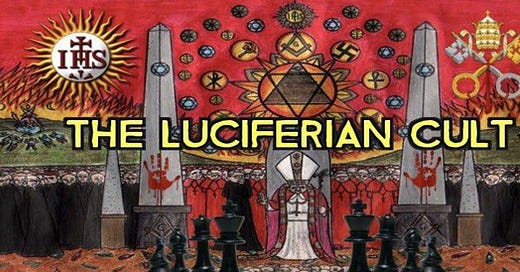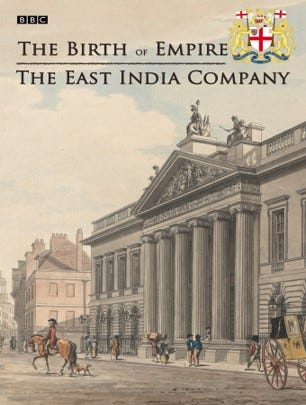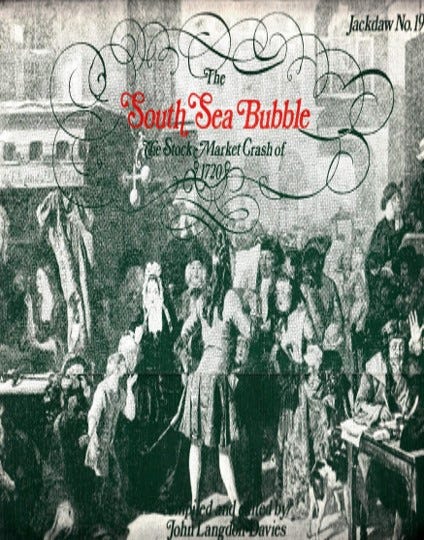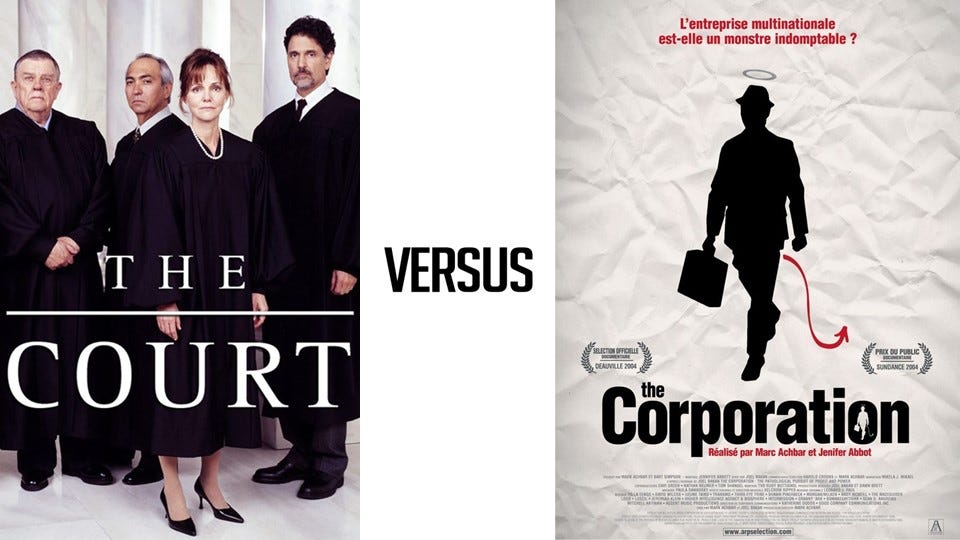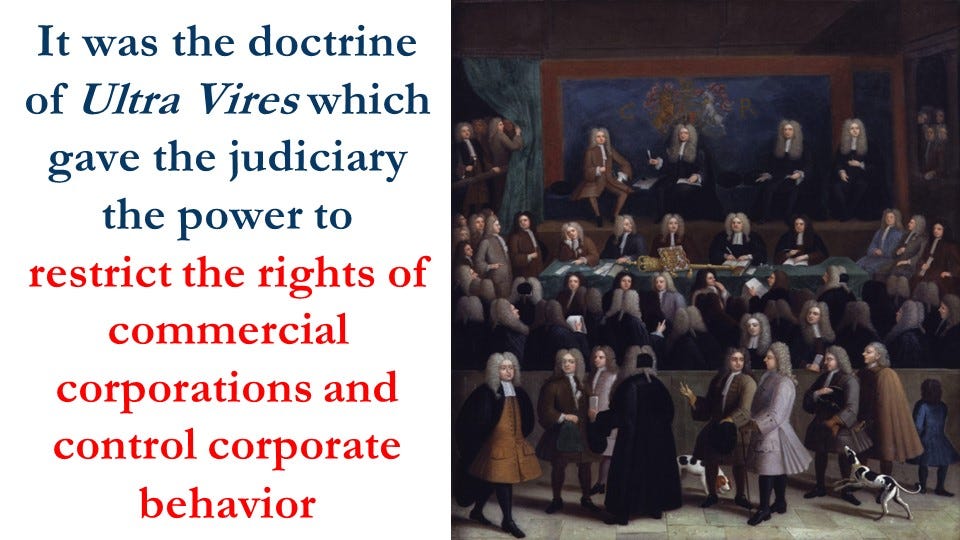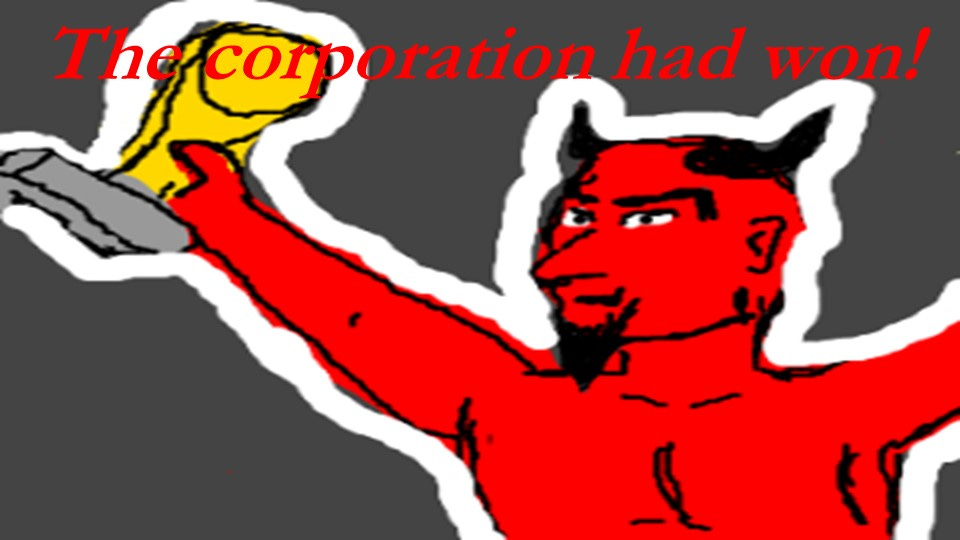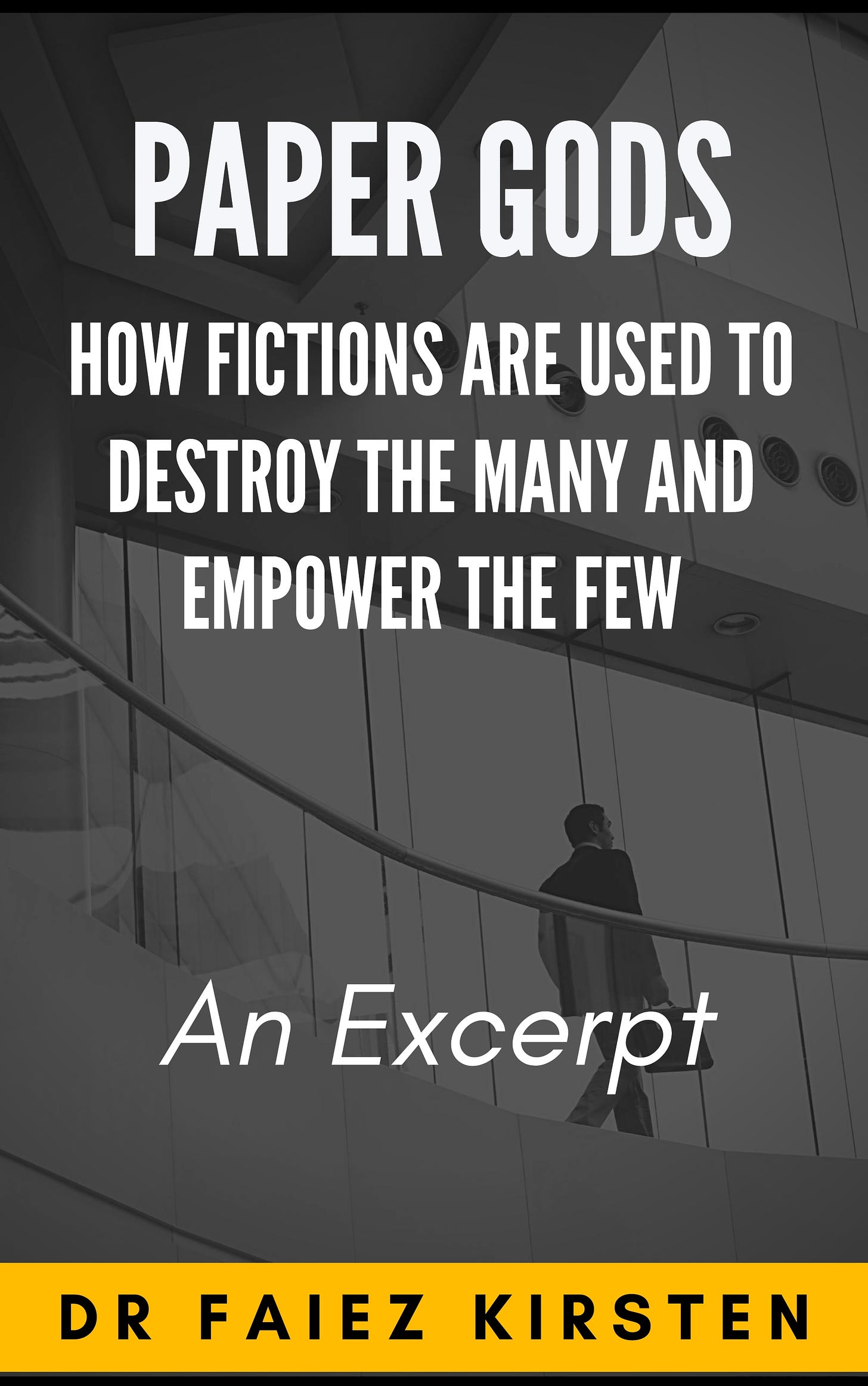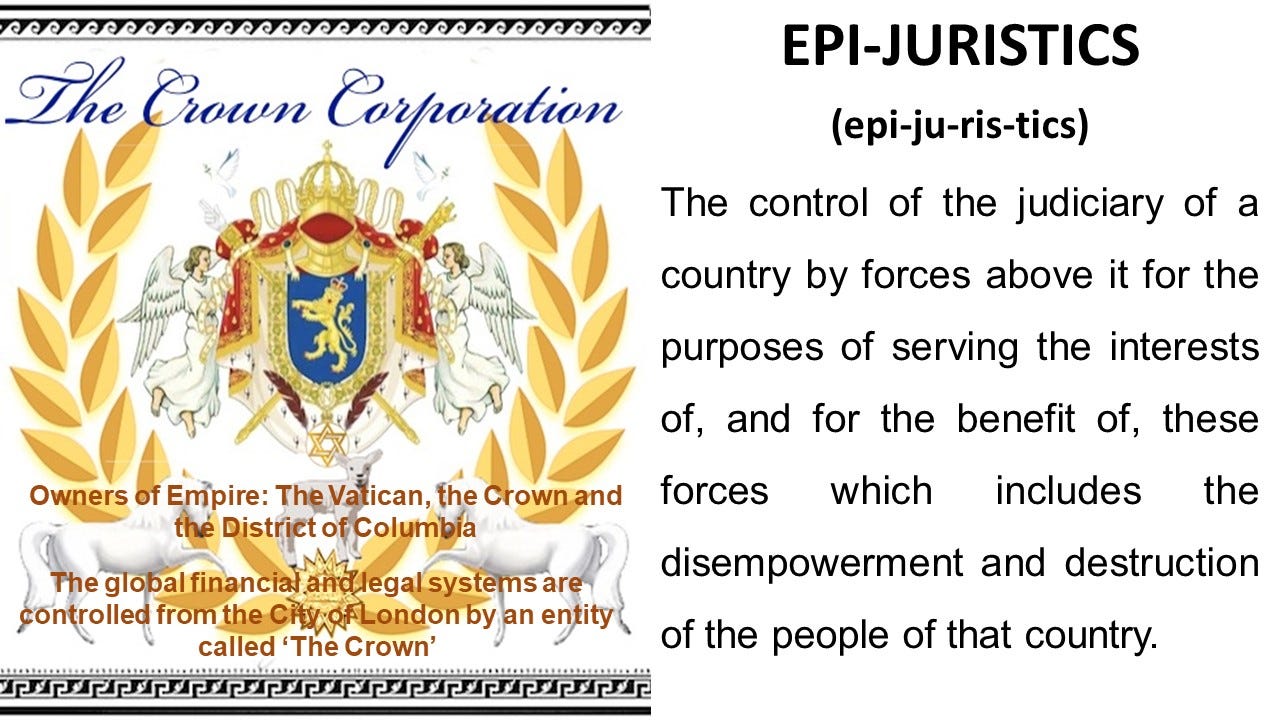Below is a chapter from one of my unfinished works entitled, ‘Paper Gods - How fictions are used to destroy the many and empower the few.’ I stopped writing this book, and another, in March of 2020 to research the claimed Covid-19 pandemic. My conclusion was that this purported pandemic was a deception. In any case, here is the chapter from ‘Paper Gods’:
SECTION 2 – WHAT EXACTLY ARE CORPORATIONS?
Chapter 1
A Fiction with Rights and Authority!
Medical doctors are responsible for the lives of their patients who are, of course, always real, living, breathing men, women and children. They are real people who have real unalienable rights bestowed on them by the Almighty Creator of the universe. These rights include the Right to Life, the Right to Respect, the Right to Justice, the Right to Freedom, the Right to Acquire Knowledge, the Right to Sustenance, the Right to Work, the Right to Privacy, the Right to Protection From Slander, Backbiting and Ridicule, the Right to Develop One’s Aesthetic Sensibilities and Enjoy the Bounties Created by Him, the Right to Leave One’s Homeland Under Oppressive Conditions and the Right to a Good Life. However, one of the things I learnt while at the business school and which initially made absolutely no sense to me at all was the idea of a fictional person which had rights and authority! And these rights were regarded as the same as human rights! I must admit that this concept of a ‘Legal Person’ or ‘Corporation’ with human rights took me a few weeks to wrap my head around simply because it seemed so utterly nonsensical. On the one hand I could understand the need for a vehicle within which to conduct commerce. But on the other hand, it seemed completely insane that the unalienable rights of real, living, breathing, men, women and children could be trampled upon and rendered meaningless by the ‘authority’ of fictional entities. Now, even after extensive research, the concept remains completely nonsensical to my rational mind. However, my view of its nonsensical nature is not the most important factor. Most important is the fact that it is completely diabolical. A diabolical concept conjured up for diabolical purposes. The evil is reflected in the meaning of the word, which is a combination of two words, namely ‘corpse’ and ‘oration’. Corpse, of course, means ‘dead body’ and ‘oration’ refers to ‘speech’ or ‘speaking’. So a corporation is a dead body speaking! In any case my rational mind also reasoned that since the Corporate entity is not real, its rights and authority cannot be real. However, based on my observation, experience, and discussions it is obvious I am an odd-man-out on this issue. The truth, as any rational mind would conclude I think, is that the Corporate entity with its own ‘laws’, which often oppose Natural or Divine Law (actually oppose Divine Commandment or Divine Instruction. Law and Commandment are not the same) is a construct of diabolical minds. And it is the primary tool that these minds use to enrich and empower themselves while keeping most of mankind in a state of disempowerment and poverty. The Corporate entity is at the heart of the tragic state in which most of humanity finds itself.
RSA Inc
So, what exactly are Corporations? Before exploring this matter, let us first take a brief look at what the Law is, and from whence it comes, specifically from within the perspective of the South African legal system. In essence the Law is simply a set of man-made rules which control the way people behave or conduct their lives. It instructs them what they have to do, what is permissible for them to do and what is not permissible for them to do. There are three main kinds of laws in this country, namely Constitutional Law, Criminal Law and Civil Law. However, there are several sources from which the laws in this country are derived, namely the Constitution, Statute Law, Common Law, Customary Law and Court Decisions.
The Constitution, the highest law of South Africa, was written by a multi-party Constitutional Assembly and given force of law by the Parliament of this country in 1996. It includes a Bill of Rights, a list of human rights which, in theory, lays the foundation for all laws. I say in theory since the Bill of Rights is not always respected. The Constitution provides the rules by which the country is governed, and it is required that all laws and actions of the State do not violate the Constitution. In fact, the State is organized according to this highest of all man-made laws and any lower-level law which is in opposition to the rules of the Constitution is subject to contestation. Furthermore, all courts operating below the level of the Constitutional Court are required to interpret the Common Law and Customary Law based on the contents of the Bill of Rights. Also, when these lower-level courts interpret the Bill of Rights, the Constitution requires them to be guided by International Law, and also non-South African Law if necessary.
The South African Parliament is the highest law-making body in the country, and parliamentarians write the statutes which constitute Statutory law. Provincial Parliaments also write Statute Laws for provinces and allow municipalities to write some laws. New statutes can overwrite or replace old ones i.e. old laws can be made redundant and new ones enforced. Statutes are also known as Acts. They can give powers to ministers or entities to make further laws known as ‘Regulations.’ South African Company Law is a set of rules which regulates Corporate entities which are formed under the Companies Act. In essence, Corporate Law is that aspect of law which controls the rights, behavior and relations of legal persons, companies, organizations and businesses. It is a legal practice relating to Corporations and includes their formation, funding, governance and termination.
Common Law was brought to South Africa by the Dutch and English settlers. Many general principles of South African Law are derived from Common Law. For example, according to this law, theft and murder are crimes. Customary Law, on the other hand, is mostly unwritten and is derived from the traditional or habitual practices of communities. Written Customary Law is not always a true reflection of the traditional practices of a community. Generally, customs become law when most or all people in a community know about and follow them, and they are enforced in some way.
Criminal Law indicates which behaviors are crimes and are punishable when committed. Crimes are seen as a wrong having been done against the State and can be committed from a Common Law perspective (such as theft for example) or statutory perspective (such as the violation of a statute or Act). Civil Law on the other hand deals with interpersonal relationships i.e. it indicates what the rights and responsibilities are of people when they interact or engage with each other. Knowledge and understanding of the rights and responsibilities of both oneself, and of others is crucial to prevent violation of Civil Law. Marriage and rental agreements are examples which fall within the ambit of Civil Law.
Okay, so we have seen what Corporate Law is. But what exactly are Corporations? In essence, a Corporation is a business enterprise which, through the legal process of ‘Incorporation’, becomes a distinct entity. In other words, the enterprise acquires a legal identity and becomes a completely separate entity from the people who operate it. Since Corporations are directly responsible for much of the mayhem and destruction around the globe, and mostly benefit only a few whilst destroying the many, there is no doubt that they spring forth from the dahal forces described earlier. Corporations are the constructs of these minds. They are the beliefs and ideas emanating from these minds and which are reflected as words on paper or as pixels on computer screens. Let us go back in history to explain what we mean.
The Luciferian Corporate System (The Satanic System)
As far back as the eighth century BC in India, merchants, traders and artisans engaged in the same economic activity or craft formed associations called shrenis. This seems to be the first type of business organization or structure to have been formed.
Moving forward, more than 2000 years, to England we find that, before the year 1600, business was typically conducted by small groups of people who shared the risks and responsibilities of their operations on a cooperative or partnership basis. These collectives had names to identify them but no distinct legal identities of their own. Commercial Corporations were non-existent at this time.
In order to streamline the functions of organizations such as churches, schools, clubs, hospitals and universities among others, which operated on a non-profit basis, and to avoid disagreements, disputes or administrative and other difficulties when their control was taken over later by new people, it was decided to ‘Incorporate’ them i.e. they were given a distinct legal identity and became a ‘Corporate Person’ which was completely separate from the people who managed them. Incorporation was only allowed for non-profit entities by the Crown of England or its government who wrote their constitutions outlining their rights, powers and purposes. And these non-profit Corporations were usually involved in activities which furthered the public good, such as the organizations mentioned. When Corporations crossed the boundaries of their constitutional limitations, they were said to be acting ‘ultra vires’ i.e. acting beyond their powers without legal authority and therefore subject to being declared invalid by the courts. For example, non-profit Corporations such as charities which generated profits were clearly acting ‘ultra vires.’
The first Commercial Corporations made their appearance in the last few years before 1600 when the Crown granted Royal Charters of Incorporation to trade associations. These were non-profit Corporations and were involved in regulating and developing trade in limited areas. They did not engage in trade themselves. Individual businesses became members of these associations which allowed them to trade in these areas. The people running these member businesses continued to assume personal responsibility for the activities of their businesses as they did prior to acquiring membership in the trade association. The East India Company was the first incorporated, non-profit trade association following receipt of its Royal Charter in 1600 allowing its members to monopolize trade in the Indies. Over the course of the 1600s the members merged their stock to eventually form one huge joint stock-owning partnership which carried out all the trade from within the Corporation. Over the next century, the partnership decided to sell its joint stock to the East India Corporation itself and received in return a share in the Corporation. In other words, the joint stock of the partnership was exchanged for individual shares for each member. The Corporation, as a separate or individual entity, then traded the stock in its own name and generated its own profits. These profits were then distributed amongst its shareholders, the partnership members. In this way the East India Corporation became the first shareholder-owned, for-profit Commercial Corporation. However, by generating profits, it was acting illegally since its actions were ‘ultra vires’; they were not sanctioned by any authority which had the power to sanction such actions. Authorities such as the government or the courts. Furthermore, the public was not consulted to determine if converting to a for-profit entity was a prudent move or not. The idea was purely a construct of the minds of the partnership members. And, unsurprisingly, the consequent illegal profit-generating activities of the Corporation which followed the conversion went ahead without any analysis being undertaken as to any possible harmful consequences such a move may hold for the public in general. Or for the environment for that matter. Ethics in business, it seems, was not a widely held value at the time. Tragically the same holds true today, and seemingly through all the time in-between. Disturbingly though, the illegal conversion of a non-profit trade association to a for-profit Corporation was not challenged by anyone!
In any case it was the advantage of protection from the numerous risks associated with doing business, and especially financial and economic risks, that the for-profit Corporation provided to businesspeople which drove them to act illegally in their pursuit of profits. The major advantage of course was that since the fictional Corporation was a separate entity from its living stakeholders, directors and managers, a barrier or veil existed between them. A barrier or veil behind which the living could hide from their actions taken in the name of the dead, fictional Corporation. Real, natural people of course must take responsibility for their actions in life and this was the case in any unincorporated business too at the time. And always throughout history also when business was conducted, including this current time too. However, Corporatization now shielded people from the individual and collective responsibilities of their business dealings. Any malfeasance or unsavory business practices could be defended in the name of the Corporation rather than the name or names of those committing the foul deeds. Exactly how a certain individual, many years ago, defended his actions in court in the name of the dead Corporation of which I was a director at the time rather than in his own personal capacity as a living man who committed the deed.
Another advantage conferred by Corporatization was that, since the Corporation was not a living entity, it could not die, unlike its living stakeholders, managers, and directors. And so, the Corporation could go on forever. At least theoretically. So, even if these people left the Corporation, including the transfer of shares by shareholders, the Corporation would continue to ‘exist.’ What is more, since it could not die, it was not liable for death taxes! Advantageous indeed! Furthermore, since the Corporation’s assets belonged to it as a separate legal person from its shareholders, if any of them were rendered insolvent for any reason they could not rely on these assets to rescue them from their difficulties. Likewise, however, if the Corporation had difficulty settling its debts the personal assets of shareholders could not be used to do so. This aspect of Corporate Law was not fully developed at that time though and the courts did permit creditors to take legal action against shareholders and directors for the debts of their company.
Given the advantages conferred by the Corporation operating as a separate entity, it is not surprising that, during the latter half of the 1600s until 1720, other non-profit trade associations converted to unlawful for-profit Commercial Corporations. Exchange of joint partnership stocks for individual shares began increasing. This was permitted by the Crown, which started granting charters to new Corporations specifically to enable them to trade as Commercial Corporations. Later on, these Corporations also came into ‘existence’ via Act of Parliament. The prime purpose it seems for the increase in granting of charters, and thereby the increase in the number of Commercial Corporations, was to develop new patents and to boost domestic trade. Funding for these new Corporations was also requested from external investors. Now, where diabolical criminal minds see the possibility of obtaining money without honest work or money that is not legitimately theirs to obtain and manage, they are sure to spring into action. And so, it is equally not surprising that dodgy Corporations were created to obtain money from investors fraudulently. We have mentioned the ‘South Sea Bubble’ of 1720. The British South Sea Company was formed in 1711 and granted a monopoly to trade in Spanish-controlled ports in South America. Investors were told that handsome profits were to be made as soon as these ports became accessible to trade. As expected, money poured into the company and the share price was driven to incredible heights by exuberant investors thereby creating the ‘South Sea Bubble’ as mentioned. But profitability remained inexplicably poor. When they could no longer convincingly explain the dismal performance of the company, the founders fled the country. It was then that investors discovered that access to these ports would never be obtained. This triggered a massive sell-off of South Sea shares with the consequent complete collapse of the share price almost immediately, triggering similar crashes of a multitude of similarly dubious companies. This was the first stock market crash.
Coming back to the East India Company, this entity expanded so greatly in India that not only did it enjoy monopoly on trade in this part of the world, but it also took control of the country’s army, its food supply, and its roads. In fact, this massive Corporation acquired the powers of a government both in India and abroad! Via its business activities, the East India Company gained control of and ruled over the whole of India. This of course was a problematic situation for the British government which realized that it had to reclaim foreign policy from this behemoth and other similar companies. It responded by terminating many of the Chartered Corporations or by nationalizing them. Their territories were confined to the British Empire. It then enacted the ‘Bubble Act’ of 1720 as a means of controlling fraudulent activity. In terms of this Act, all commercial activities by both Corporations and partnerships, ‘tending to the common grievance, prejudice and inconvenience of His Majesty’s subjects’ were rendered illegal and invalid. Furthermore, all speculative buying and selling of shares and the facilitation of such trade by stockbrokers was forbidden by the Act. From the legislation of the Act in 1720 up until 1825 only individuals who authentically took up management positions in Corporations or partnerships were legally permitted to buy shares in these entities. And during this period all new businesses operated as partnerships. The State was unwilling to allow the formation of new Corporations. But it was also reluctant to prosecute under this Act. Despite the numerous cases of corporate fraud and corporate failures at the time, there is only one recorded instance of prosecution under the Bubble Act. However, the lack of public resources was also a contributory factor in the paucity of prosecutions.
Now money makes the world go round as the saying goes. And since the State did not have sufficient of it to build the much-needed canals and waterworks at the time, it had to look to private investors who did have the means to finance these projects. However, funding projects where they would be at risk for any debts and liabilities incurred made them reluctant to invest unless their investments were made in Corporate entities. Limited liability was critically important to them. And so, it came to be that Parliament decreed that specific types of Corporations, which it referred to as ‘Statutory Corporations’ were to be created to protect the financiers in the event of corporate failures. Legal defences would be in the names of the Corporations. And the formation of these was to be controlled. Each one of them would be created for a specific project only, such as the building of a specific canal for example. It is noteworthy that famous Scottish philosopher, economist and author, Adam Smith opined in 1776 that it was not in the public interest for businesses or trades to be conducted through the Corporate form. They should be managed as partnerships, except for canal building, waterworks, insurance, and banking businesses. These should be Incorporated entities.
Unlike Corporations which could go on forever, the Bubble Act had a limited lifespan. It was repealed in 1825 permitting the trading of shares freely. Similarly, the restriction on Corporations that they must ‘not tend to the common grievance, prejudice and inconvenience of His Majesty’s subjects’ was lifted. And, from this year up until 1856, a number of Acts saw the end of the controlled setting up of Corporations and the introduction of the ‘Registered Corporation’, the type which is used up to this day. In 1844 the Joint Stock Companies Act legislated a simple process of registration via the Company Registrar whereby a legal person, the Commercial Corporation, could be brought into ‘being’. The types of commercial activities of these legal persons were subject to approval by the Registrar although the founders of the Corporation could determine its purposes and limitations. However, the registration process required that this purpose be described in the ‘Objects Clause’ in its constitution.
According to Hansard (the verbatim record of transcripts of Parliamentary debates in Britain and other Commonwealth countries) in a debate in the House of Commons, Gladstone, one of the presidents of the Board of Trade and a sponsor of the Registered Corporation, stated:
‘Joint Stock Companies at present could not be formed with any privilege such as that of suing and being sued, except, by coming to Her Majesty in Council, or by applying to Parliament… Under this Bill, there would be a power for the first time, for persons to associate themselves in companies, for the purpose of commercial pursuits, without the fear of interference from any human being whatsoever.’
The Bill was obviously proposed with the unambiguous purpose to bestow civil and human rights upon the fictitious Corporate Person.
Unsurprisingly, the significant risks and dangers of legalizing such a nonsensical concept were understated. Hansard further states:
‘Mr. Parker agreed that great harm had been done by the abuse of the principles of Joint-Stock Companies; but … One great principle distinguishing this country from others was the non-interference of the Government with the regulations of trade.’
Initially, creditors of Registered Corporations which were unable to settle their debts could get the money owed to them from their shareholders. There was no legal protection of limited liability for shareholders. It took a decade of debating for an Act to be passed for this protection to be legislated. In 1855 the passage of this Act eliminated the possibility of creditors legally pursuing shareholders for the debts of their company. The only risk shareholders faced was losing the money they invested in the event of its failure. Their liability was limited to the amount they had paid for their shares. They had no liability or responsibility beyond that. Not only did this law now protect shareholders from any responsibility for the debts of the Registered Corporation,
but it also shielded them from the consequences of the way in which their funds were used i.e., it shielded them from the actions of the managers or directors of the company.
Thus, for example, if shareholder money was used to develop weapons to kill innocent civilians there was no liability at all on shareholders. The building of such weapons and the taking of innocent lives was of course seen purely as the decisions of those carrying out these actions. However, it was shareholder money which made this diabolical situation possible in the first place. But the lawmakers, unsurprisingly, turned a blind eye to this fundamental issue, which has since been a major factor in the chaos, death, and destruction the world has been experiencing. It is of course not only the building of weapons for nefarious purposes using limited-liability shareholder funds but numerous other situations too, such as the development of deadly pharmaceutical drugs and vaccines, which do the same. Tragically, the use of such funds has been responsible for the destruction of people and planet alike for a long time now.
But what arguments did proponents of limited liability put forward to win the debates and get the Act passed? There were two, the first being that it would benefit the Middle and Working Classes. According to their logic, if this group, who were in fact classified as the poor, bought shares in a company which failed, they would be protected. These logicians seemingly had the interests of the poor at heart. Unfortunately, their apparent concern for this group seemed to have blinded them to the fact that it is not only shareholders who can be devastated in the event of a corporate failure. Those who invest their time, expertise, and effort daily to keep the enterprise operational, the people working there, are even more devastated in the event of its failure. They lose much more than absentee shareholders. And what percentage of the poor could then, and can now, afford to purchase a sufficient quantum of shares to significantly improve their wealth? In any case it is obvious then that the Limited Liability Corporation was designed to favour and protect shareholders while placing the burden on its employees to bear the cost of failure, which as we have seen is often due to the malfeasance of managers and directors rather than that of non-management workers.
In her book ‘The Divine Right of Capital’ author Marjorie Kelly describes several principles of an Economic Aristocracy and an Economic Democracy. One of the principles of an Economic Democracy is that Under market principles, wealth does not legitimately belong only to stockholders. Corporate wealth belongs to those who create it and community wealth belongs to all. See Appendix.
The second rationale provided to support limited liability was that human investors and funders would clearly be aware of the risks they would face by dealing with or investing in a fictional entity. The term ‘Limited’ or the letters ‘Ltd’ following the name of the Corporation would alert them to this. No-one could claim ignorance of the risks of entrusting their money to a fictional person. The warning would be right there beside the name! The reality of course is that they would be entrusting their money to a real man or woman or real men and women hiding behind a fictional person! In any case, there is no doubt that since the time of coming into being of the Limited Liability Corporation that many investors have made stupendous returns on their investments. Their bet that the Corporate Person would ‘come to the party’ and multiply their money, paid off handsomely. But the risks are of course very real. As we have seen, the numerous corporate failures with their decimation of shareholder value and consequent misery and mayhem, certainly indicates that the letters ‘Ltd’ should be taken very seriously indeed. Very, very seriously. The tragedy though is that once again, in providing their second reason for espousing limited liability, the logicians once again forgot about those who make the operation of the enterprise possible. The working slaves. Why slaves? Of all the descriptions of the term ‘slave’ one of them is ‘one who has no say or control in the running of his or her own life.’ The letters ‘Ltd’ after the name of their employing Corporation mean nothing to those whose income, and lives depend on the fiction. They have no choice in the matter. And what’s more, regarding the limited liability logicians, is that their vision was limited too. They did not see that the Limited Liability Corporation, with its inherent risk of causing destruction, would become ubiquitous. These fictions would be everywhere. Today, Limited Corporate Persons conduct virtually all business operations across the globe. And the short-sightedness of the logicians also prevented them from seeing that the Corporate Person could conduct unsavoury operations virtually without risk by generating Subsidiary Corporate Persons which would conduct these activities on its behalf! See Appendix.
A point to highlight here is that, as we have mentioned, a Corporation is a fictional legal entity (a non-living legal person, or more specifically, a non-existent legal person!) while an organization is a group or community of living men and women who have come together to work towards achieving one or more goals or objectives. It is crucial to distinguish between the living and the non-living. The real and the fictional. Certainly though, those who own the dead Corporation own and control the community of living men and women employed by it, either directly or indirectly.
Now, given the enrichment of the few and the death and devastated lives of multitudes and the destruction of the planet, it seems, on the face of it, that the short-sighted limited liability proponents unintentionally caused massive harm to most people and their home they call Earth. After all, parliamentary debaters were only concerned with the protection of investors and their funds. Their prime concern was legally protecting funders. No discussion or debates took place as to whether greedy or dysfunctional corporate directors may cause harm to the health and wellbeing of employees, the public and the planet. But was the harm caused to people and the planet since the passage of the Limited Liability Act, unintentional? Parliament's view is that since fictional Corporations officially have all the rights of a human person, they could choose their own objectives and any control of their activities was the function of the courts and not that of government. It is not the government's place, it was, and still is, believed, to interfere in business innovation and activity. It should be left to the courts to decide whether any Corporate action is harmful or not. This is astounding, of course, given the ongoing suffering and deaths across the world, and destruction of the planet, which is directly attributed to Corporate activity. Should governments not have the power to put a stop to this? In any case, in our view, the ignoring of harm to people and the planet is either a reflection of ‘Epi-politics’ (the control of politicians and governments by forces and factors above them (See Appendix) or the failure of governments to look out for the well-being of the people, which is their responsibility. And we should not, of course, discount the possibility of malicious intent of diabolical minds. We will examine the human mind later.
But let us for now further pursue the issue of the control of Corporations by the courts. Now, it was the doctrine of ‘ultra vires’ which of course gave the judiciary the power to restrict the rights of Commercial Corporations and control Corporate behaviour. In fact, the 1844 Act which brought Registered Commercial Corporations into being presumed that this doctrine would be used by the courts to keep Corporate behaviour in check. However, since it was dysfunctional and diabolical people who were provided with a shield behind which they could operate, it is not surprising that for more than thirty years from 1846 several cases concerning the activities of Commercial Corporations were brought before the courts. It was through these cases that judges at the time stamped their authority and unambiguously demonstrated that the doctrine of ‘ultra vires’ did apply to Commercial Corporations. They left no doubt in any minds as to who controlled Corporate behaviour. In one of the cases involving two railway corporations (East Anglican Railways Company and Eastern Counties Railways Company) Chief Justice Jervis stated:
‘It is clear that the [Eastern Counties Railway Co] have a limited authority only, and are a corporation only, for the purpose of making and maintaining the railway sanctioned by the Act; and that their funds can only be applied for the purposes directed and provided for by the statute.’
And in the Shrewsbury Railway Company vs L&NW Railway Company Justice Turner said:
‘These bodies have no existence independent of the Acts which created them, and they are created by Parliament with special and limited powers, and for limited purposes… The fact of their being endued with such powers … only shows that Parliament did not think fit to entrust them with more extended powers, or to incorporate them for other purposes.’
Furthermore, in another later case (between Eastern Counties Railway Station and Hawkes) showing Registered Statutory Corporations who is in control of their behaviour, Chief Justice Pollock left no doubt that actions beyond their objectives would not be tolerated by declaring:
‘A Parliamentary Corporation is a Corporation merely for the purposes for which it is established…; and it has no existence for any other purpose. Whatever is done beyond that purpose is ultra vires and void.’
However, due to the power given to founders to create their own objectives clauses in their constitutions, it was expected that profit-hungry Corporations would do all in their power to see the end of restrictions on their activities by the doctrine of ‘ultra vires.’ So, it is not surprising then that this is exactly what happened. In a case in 1884 between Bournemouth Corporation and Watts the judiciary concluded that only the directors, shareholders, and in some instances, creditors of Corporations could use the ‘ultra vires’ principle to contest Corporate actions. No other entities had this right. Furthermore, sharp legal minds representing Corporations saw that the Joint Stock Companies Act of 1844 allowed them to evade the Courts by widening their objectives. Over time the objectives clauses of Corporations enabled them to garner an increasing number of rights with the shrewd minds constructing the final clause to state:
The objects specified in each paragraph of this clause shall be in no way limited or restricted by reference to or inference from the terms of any other paragraph or the name of the company.
However, insightful judges refused to allow such clauses. For example, in 1902 Justice Swinfen Eady in the case between the Mysore Reefs Company and Stephens stated:
‘It is not right to accept a construction which would virtually enable the company to carry on any business or undertaking of any kind whatsoever.’
Unsurprisingly though, Corporations ignored his judgement. They could care less about any illegal activities. They simply included wide-ranging objectives clauses in their constitutions and did as they pleased. They believed they had the right to do anything they wanted. In fact, such illegal Corporate activities continued for more than six decades following the Eady judgement and during this period many Corporations engaging in such activities were dragged to Court. Those courageous judges whose legal opinions were that these Corporations were guilty of acting ‘ultra vires’ were attacked by both Corporations and Parliament alike and accused of restricting their freedom to trade. Which is not surprising, of course, when dysfunctional and diabolical minds are given the legal right to make as much money as possible in the name of a fictitious entity. But surprisingly, or perhaps not, the judiciary eventually caved in to this onslaught. In 1966, in the case between Bell Houses Limited and City Wall Properties Limited, the Courts surrendered to the Commercial Corporations when the Court of Appeal allowed the fictitious person to include in its objects clause the powerful right to:
‘Carry on any other trade or business whatsoever which can, in the opinion of the board of directors, be advantageously carried on by the company in connection with or as ancillary to any of the above businesses or the general business of the company…’
Through this ‘Bell Houses clause’ as it came to be known, the Court submitted to the Corporations by transferring its power and right to control them to the Board of Directors of each Corporation.
It was the Companies Act of 1989, however, which hammered the final nail in the coffin of the limitation on the rights of Registered Commercial Corporations through the doctrine of ‘ultra vires’. This Act still required the Corporation to describe its objectives in its constitution. However, it allowed it to describe itself as a ‘general commercial company and that it had the ‘power to do all such things as are incidental or conducive to the carrying on of any trade or business by it.’ And the final transfer of massive power from the defeated judiciary to the victorious Corporation was seen in this sentence of section 35(1) of the Act, ‘the validity of an act done by a company shall not be called into question on the ground of lack of capacity by reason of anything in the company’s [objects clause]’.
The Corporation had won. The people and planet had lost.
One could almost imagine the Corporation flashing the slogan:
Limited liability? Absolutely! Limited rights? Hell no!
Please note that when I say ‘empower the few’ I mean financially. Certainly, those who control the world are super wealthy - financially. Oligarchs who own and control virtually all governments. Billionaires and trillionaires in terms of money and material possessions. Their Net Asset Value is extremely high. Estimated to be in the billions and trillions of dollars. They have a very high material worth. However, from a psycho-spiritual perspective these people are extremely impoverished. Their Net Psycho-Spiritual Value is very low, and very likely even zero. They are psycho-spiritually worthless. They are of absolutely no use to humanity. In fact, Satanism is a severe psycho-spiritual sickness. This is reflected in the chaos and carnage the satanic globalist cabal causes in the world. And although this Luciferian Cult is referred to as the ‘Black Nobility’, in my view these psychopaths are the Black Low-bility. They are the lowest of the low. The scourge of humanity. These Luciferian Corporatists are the enemy of humankind. And those who legitimize them, willingly and actively participate in their satanic system and emulate them, are in the same category.
LUCIFERIAN DOCTRINE explained by Hans Wilhelm
Appendix
It began with fraud
Concerning the history of Corporations, the first Corporation to act for commercial purposes did so on a fraudulent basis and the courts and governments lost the battle to control them. It is hardly surprising then that fraud permeates the Corporate world and that Corporate failures are so common.
I coined the term ‘Epi-juristics’ years ago to describe the control of the judiciary of a country by forces above it.
Corporatization and Corporatism
For the purposes of this work, these terms are used interchangeably and refer to the creation of Corporate entities for the purpose of financially empowering the few in order to take over the world and achieve full-spectrum dominance and to disempower and destroy the many.
Maximizing Profit
According to a document entitled “South African Company Law for the 21st Century – Guidelines for Corporate Reform” published by the South African Department of Trade and Industry (May 2004) “Traditional company law (prior to 1994) enabled companies to embark strictly on the ‘shareholder-oriented approach, the main focus being on the owners of equity. The emphasis, in accordance with traditional company law, has been on the role of the directors, auditors and shareholders in managing and overseeing the company’s business primarily for the benefit of the shareholders. Most of the checks and balances on the powers of the controllers of the company were aimed at considering, primarily, one interest group, namely members of the company. In terms of this approach, the interests of the shareholders are paramount and interests of other stakeholders are considered only if their advancement will lead to shareholder value maximization, that is ‘through the prism of shareholder profit maximization’.”
The Divine Right Of Capital – Principles of an Economic Aristocracy and an Economic Democracy:
Economic Aristocracy
1. The Principle of Worldview: In the worldview of corporate financial statements, the aim is to pay stockholders as much as possible and employees as little as possible.
2. The Principle of Privilege: Stockholders claim wealth they do little to create, much as nobles claimed privilege they did not earn.
3. The Principle of Property: Like a feudal estate, a corporation is considered a piece of property – not a human community – so it can be owned and sold by the propertied class.
4. The Principle of Governance: Corporations function with an aristocratic governance structure, where members of the propertied class alone may vote.
5. The Principle of Liberty: Corporate capitalism embraces a predemocratic concept of liberty reserved for property holders, which thrives by restricting the liberty of employees and the community.
6. The Principle of Sovereignty: Corporations assert that they are private and the free market will self-regulate, much as feudal barons asserted a sovereignty independent of the Crown.
Economic Democracy
1. The Principle of Enlightenment: Because all persons are created equal, the economic rights of employees and the community are equal to those of capital owners.
2. The Principle of Equality: Under market principles, wealth does not legitimately belong only to stockholders. Corporate wealth belongs to those who create it and community wealth belongs to all.
3. The Principle of Public Good: As semipublic governments, public corporations are more than pieces of property or private contracts. They have a responsibility to the public good.
4. The Principle of Democracy: The corporation is a human community, and like the larger community of which it is a part, it is best governed democratically.
5. The Principle of Justice: In keeping with equal treatment of persons before the law, the wealthy may not clam greater rights than others, and corporations may not claim the rights of persons.
6. The Principle of (R)Evolution: As it is the right of the people to alter or abolish government, it is the right of the people to alter or abolish the corporations that now govern the world.
Multiple Personality Disorder
Commercial Corporations can create multiple separate fictional Subsidiary Corporations via which risky and perilous operations can be conducted but from which the sole shareholder Parent Corporation is immune from all liability. In fact, these subsidiaries may be registered in different countries and tracing the Parent Corporation and its directors, who are ultimately responsible for any harm caused, may be impossible.
Party Time
Corporations have the right to lobby and fund political parties, which of course leads to ‘Epi-politics’, another term I coined years ago.
Happily polluting and destroying the environment
Corporations are legally permitted to exploit natural resources and pollute the environment both in their own and foreign countries whilst the public has to live with the mess and destruction or clean it up themselves!

